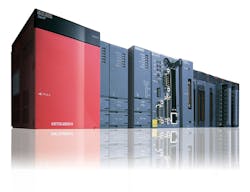The automotive industry’s pursuit of lighter vehicles has been an incremental process spanning 30 years. Although rules regarding fuel efficiency standards might ultimately be modified, the past eight years have seen a considerable push to alternatives like low-carbon steel frames and aluminum body panels to help make lower fuel use a possibility.
The plastic injection-molded bumpers made by a large tier-one supplier were among the first products in the modern car era to reduce weight on vehicles. Injection molding machines (IMMs) from UBE Machinery, with a clamping force of up to 3,500 tons, produce a range of plastic bumper types. But the three legacy machines used to make the bumpers were in need of an overhaul and upgrade as replacement components became too difficult to track down.
“The tier-one supplier wanted a retrofit of the controls, HMI software and machine components instead of buying three new injection molding machines,” says Joe Palace, senior electrical engineer at Patti Engineering, a Control System Integrators Association (CSIA) member based in Detroit.
Patti Engineering was brought in to replace Mitsubishi Electric A Series programmable logic controllers (PLCs), which Mitsubishi no longer supported, with Mitsubishi’s Melsec-Q Series PLCs. Patti Engineering also updated the machines’ human-machine interfaces (HMIs) to the InduSoft Web Studio platform. They replaced the HMI hardware, upgraded processing speed to 64 bit, and implemented a Windows 7 operating system.
The multi-phase project had four areas of focus: the main control panel, hot runner panel, shuttle table panel and the operator station. Each machine has multiple HMI panels with one operator station for dedicated control and monitoring that uses serial communication (RS-485) to send and receive operational data from the main PLC. The operator station provides an added dual-output serial card in a PCI expansion slot.
Also included in the machine retrofit was the removal of embedded HMI software, which was replaced with InduSoft Web Studio that enables machine data to move quickly to IT enterprise business platforms. The software platform increases options for the automotive supplier, such as thin-client capability, OPC UA built-in functionality, better graphics and Open Database Connectivity (ODBC) worksheets. The ODBC worksheet functionality allows an operator to choose the data needed from a specific production cell in an Excel workbook before importing it into a SQL server.
Manufacturing bumpers
Each IMM starts production by feeding material granules via a hopper into a heated barrel and then moving the material to heater bands and a reciprocating screw barrel. The machine moves the heated plastic to a mold cavity to create the form. The upgraded hot runner panel on the machine controls the temperature of the mold heaters, using information via the operator station, the PLC and feedback from the field devices. The panel uses MelsecNet/B data link and Ethernet.
The main control panel on the IMM consists of three QnA PLC racks, with a Q4ACPU responsible for process control. The upgrade from the A Series to Q Series includes special function modules, such as single-axis positioning, high-speed counter, analog I/O and, of course, a CPU upgrade.
“When you do a retrofit change, integrators rely on the supplier to help decipher the path from the old to new hardware,” Palace says. “For this application, we needed to replace many components, and they (Mitusbishi) helped expedite the process with correct part numbers.”
The modernization project also offers multiple network modules to provide better data communication within the plant and to external customers. Other modules consist of a serial communication computer link and a master module converter to the CC-Link protocol Mitsubishi products use.
Quicker communication speed is crucial for this sizeable industrial machine with multiple work cells, and so is the delivery of raw materials to make molds and move finished products to storage. The updated shuttle table panel has its own PLC with an A2ASCPU that communicates through parallel and serial communication to the main panel control. Key components in the update for this panel are the CC-link master module and Hokuyo optical data transmitter.
The machine integration and retrofit involved many different phases, and the integrators implemented the upgrades during scheduled downtimes. The IMM modernization project continues to move forward, with updates for drives and motors coming soon.
About the Author
Grant Gerke
Digital Managing Editor

Leaders relevant to this article:
